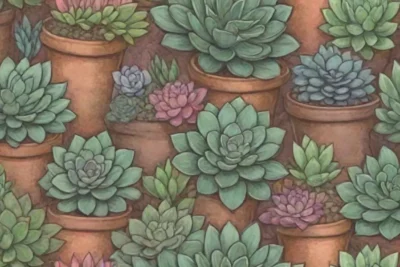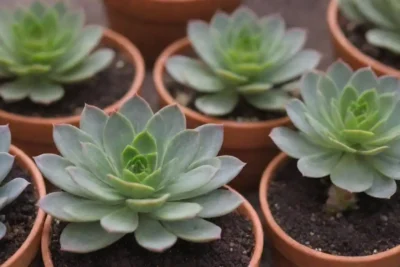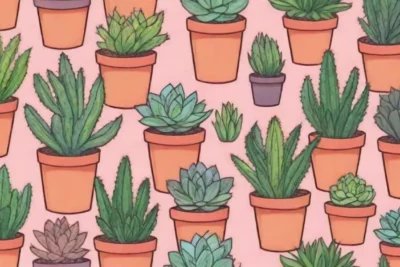
How to Identify the Growth Stages of Your Favorite Succulents

Introduction
Succulents have become immensely popular in recent years, not just for their aesthetic appeal but also for their low maintenance requirements. These resilient plants, which store water in their leaves, stems, or roots, can thrive in arid conditions and add a touch of greenery to any space. However, understanding how to care for them involves not only watering and light considerations but also recognizing their growth stages. By knowing how to identify these stages, you can provide the right care at the right time, ensuring your plants remain healthy and vibrant.
In this article, we will delve into the growth stages of succulents, offering detailed descriptions and care tips for each phase. We will explore the germination period, juvenile stage, mature growth, and flowering, making it easier for you to support your succulent's needs throughout its life cycle. By the end of this guide, you'll be equipped with the knowledge to nurture your favorite succulents, ensuring they flourish beautifully in your home or garden.
Germination Stage: The Beginning of Life
The initial phase of a succulent's life is the germination stage, where seeds begin to sprout and develop into young plants. This is a critical time that requires specific conditions for successful growth. Typically, this stage can last anywhere from a few days to several weeks, depending on the type of succulent and its environmental conditions.
Conditions for Successful Germination
In order to induce successful germination, it is essential to create the right environmental conditions. Succulent seeds generally prefer a warm and moist atmosphere. A temperature range of 65°F to 75°F (18°C to 24°C) is optimal. Using a well-draining cactus mix or pouring stones into the potting soil will ensure that excess water drains quickly, preventing root rot. Maintaining a humidity level of around 40-60% will also help in the germination process.
To further enhance the chances of germination, provide adequate light but avoid direct sunlight, which can scorch the delicate seedlings. A bright, indirect light source is ideal. You might also consider using a grow light for better control over the light exposure, especially if you’re starting seeds indoors.
Care Tips During Germination
Once you have sown the seeds, it’s critical to check the soil moisture regularly. The top layer of soil should feel slightly damp but not overly wet. Misting the soil may suffice until seedlings emerge, and they can be watered more thoroughly as they outgrow their initial pod. Complete patience is key during this stage; some seeds can take longer to sprout than others, so don't be discouraged if progress seems slow!
Whenever the first leaves—known as cotyledons—begin to appear, you've successfully navigated through the germination stage. The emergence of these leaves is a positive indicator that your seeds have taken root and started to grow. Keep monitoring the moisture and light levels to give your new succulents the best chance as they transition to the next stage.
 The Influence of Temperature on Succulent Growth Patterns
The Influence of Temperature on Succulent Growth PatternsJuvenile Stage: The Growth Spurt
Following germination, succulents enter the juvenile stage. This phase generally lasts about 6 to 12 months (though it can vary by species). During this period, young succulents will grow rapidly, developing their unique shapes and form.
Characteristics of Juvenile Succulents
In the juvenile stage, succulents typically feature small leaves that are relatively fat and plump, indicative of their water-storing ability. Depending on the species, they can take on a wide variety of colors and shapes, leading to distinct appearances. For example, Echeverias may develop rosette shapes, while Haworthias often display smoother, varied leaf textures.
It's essential to provide adequate light during this stage since the young succulents require it for photosynthesis, which helps them grow. Ideally, they should receive around 4-6 hours of bright light daily. Too little light may cause them to stretch towards the light source (a phenomenon called etiolation), while too much direct sunlight could harm the delicate leaves.
Care Considerations for Young Succulents
During the juvenile stage, it’s crucial that you establish a balanced watering schedule. Generally, watering every two weeks is adequate, but this can vary based on the humidity, temperature, and potting medium. As they grow, you might consider transplanting them into larger pots to give them ample room to thrive. Be sure to use potting mixes that allow for optimal drainage, such as blends made with perlite or pumice.
This is also the ideal time to begin introducing fertilization. You can use a diluted liquid cactus fertilizer or a slow-release fertilizer that is specifically designed for succulents. Feeding periodically during the growing season from spring to autumn will enhance their growth. However, be cautious not to over-fertilize; this can lead to unsightly leaf burn or stem elongation.
Mature Stage: Peak Development

As your succulents mature, they transition into the mature stage, where their growth slows and the plants begin to solidify their structures. Mature succulents may take anywhere from 1 to 5 years or more to reach this stage, depending on the species.
 Tips for Encouraging Robust Growth in Your Succulents Indoors
Tips for Encouraging Robust Growth in Your Succulents IndoorsFeatures of Mature Succulents
Mature succulents will possess a developed system of roots and will exhibit thick, hardy leaves. Their overall shape becomes more defined, showcasing the species’ natural characteristics. As they reach this growth stage, succulents are often less susceptible to environmental stresses and require less frequent watering. Even during the hottest months, mature succulents can go longer between waterings without harmful effects.
Observing a mature succulent can be an incredible experience; you may find that they start to form pups or offsets. Some plants, like Aloe Vera, naturally propagate by producing these baby plants. You can gently separate these pups from the main plant and transplant them into their own containers, allowing for even more succulents in your collection!
Care Guidelines for Mature Succulents
As your succulents transition into this stage, you can adjust your care routine accordingly. The frequency of watering should generally be reduced. Checking for dryness by sticking your finger in the soil should become the norm. When the soil feels dry to the touch 2-3 inches deep, it’s time to water them again. Always observe how the plants react, as some might thrive on different watering intervals.
Integrating seasonal care practices is also crucial; as the seasons change, so will the care needed. In winter, some succulent species enter a state of dormancy, meaning they require even less water and light. This could involve reducing watering sessions to once per month or even less for cool zones. Provide your plants with a more shaded location if required to prevent sunburn or damage during these transitional periods.
Flowering Stage: A Flourish of Beauty
The final growth stage of succulents is the flowering stage, where many succulents show off their vibrant blooms. Not only does this stage mark the culmination of a succulent's life cycle, but it also represents an opportunity for the gardener to showcase their plant care skills.
Bloc of Blooming Succulents
Each species has its unique flowering calendar. For many succulents, flowering typically occurs in spring or summer, while some will follow a fall-blooming cycle. The blooms can be stunning, ranging from simple yellow flowers in Haworthias to elaborate, multi-colored clusters in Sedums. Flowering generally signifies a healthy plant that has reached maturity and is thriving in its environment.
Encouraging flowering is often about creating the proper conditions. Ensuring your succulents receive adequate light, especially during the growing season, can increase the chances of blossoming. Additionally, some gardeners opt to stress their succulents slightly by adjusting their watering routines before flowering season, as environmental changes might induce blooming behavior.
 The Interplay of Humidity and Growth in Succulent Plant Care
The Interplay of Humidity and Growth in Succulent Plant CareCare During Flowering
While flowering is indeed an exciting period, it can also be labor-intensive. During the flowering stage, avoid moving the plant around too much, as it can fall off the bloom stalk, causing damage to the plant and leaving it vulnerable. It’s also crucial to avoid over-fertilizing at this stage, as this can lead to burned flower buds or stunted growth.
Once the flowers have faded, many succulents often require a period of recovery. After removing spent flowers, it’s essential to allow the plant to focus its energy on recovery instead of feeding again immediately. Propagation via seed collection is a possibility during this stage as well, allowing for growth and the promise of brand-new plants in your garden.
Conclusion
Recognizing the growth stages of succulents is vital for any succulent enthusiast aspiring to nurture healthy, thriving plants. From the delicate beginnings during germination to the robust growth of maturity and the vibrant pleasures of flowering, each stage holds its unique charm and requirements.
Understanding how best to provide care throughout these stages ensures your succulents not only survive but flourish. By creating optimal conditions for each phase—be that proper watering, light, or growing medium—you affirm your commitment to cultivating your plant’s life cycle. Remember that patience is essential; each succulent will grow at its own pace, influenced by care, conditions, and species characteristics.
So whether you're a novice gardener or a seasoned plant parent, delve into the world of succulents with joy and curiosity. Embrace their unique growth stages, and witness the endless beauty and resilience they offer as they flourish through time in your care! Your efforts will undoubtedly yield delightful results, turning your space into a lush, green sanctuary that celebrates life—one beautiful succulent at a time.
If you want to read more articles similar to How to Identify the Growth Stages of Your Favorite Succulents, you can visit the Growth Patterns category.





You Must Read